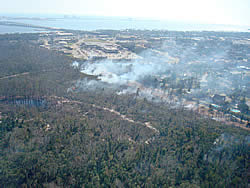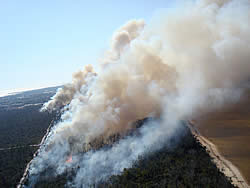
National Fire Plan Success Story
Prescribed Fire Task Force Implements Fuels Treatment Efforts
Gulf Islands National Seashore, Florida and Mississippi
National Fire Plan - Fuels Reduction
2008

Black-line operations adjacent to the park boundary in Naval Live Oaks. NPS photo by Kevin Merrill.

Interior ignition of Naval Live Oaks 2 (NLO2) burn unit, Gulf Islands National Seashore. NPS photo by Kevin Merrill.
In early 2008, resources from the National Park Service joined in Florida and Mississippi to become "Task Force Arrowhead" unofficially, a prescribed fire task force with the goal of reducing hazardous fuels accumulations at two sites within Gulf Islands National Seashore. Multiple hurricanes and fire exclusion have led to unnaturally high fuel loadings in natural areas managed by the National Seashore. The sites targeted for fuels treatment were wholly within the city limits of Gulf Breeze, Florida, and Ocean Springs, Mississippi.
"Task Force Arrowhead" was composed of the following resources: Great Smoky Mountains Fire Use Module which provided planning efforts and burn overhead; a type 3 fuels funded helicopter provided by the Southeast Region; two type six engines and fire effects monitors provided by Natchez Trace Parkway; a type six engine from Everglades National Park; and, a type six engine and a squad of firefighters from Gulf Islands National Seashore. Local cooperators for individual burns provided additional resources. These resources included a type six engine and tractor plow provided by Mississippi Sand Hill Crane National Wildlife Refuge, tractor plows provided by Pensacola Naval Air Station and Eglin Air Force Base, and an initial attack plow operator provided by The Nature Conservancy.
The task force was able to treat a sixty-acre site in Ocean Springs, Mississippi. This site was bounded by private homes and grade school and less than a half-mile from a major highway and hospital. This was a first entry burn and additional treatments are planned. Within Gulf Breeze, Florida, the task force treated 277 acres of hurricane damaged scrub oak, sand pine and long-leaf pine. As in Mississippi, these units were in close proximity to major highways and bridges, private homes and a community hospital.
Although the task force disbanded after one week due to weather constraints, it is hoped that the prescribed fire task force concept can be extended to other areas within the Southeast Region.
Contact: Dave Loveland, Great Smoky Mountains Fire Use Module, phone: (865) 436-1711.